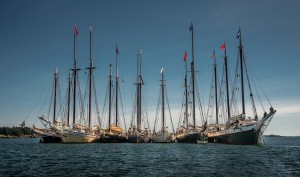Maine Windjammers held to a high standard in Coast Guard inspections
Maine Windjammers held to a high standard in Coast Guard inspections
It’s fit-out season for the Maine Windjammer Association fleet. The whirr of sanders and the smell of varnish is in the air at Windjammer Wharf, North End Shipyard, and on the docks in Camden and Belfast. ‘Tis the season to repair, rebuild and improve the eight historic windjammers that make up the Maine Windjammer Association fleet. It’s also inspection season, and that prompted this blog post about what’s involved in a Coast Guard inspection for Maine’s historic fleet of windjammers. Knowing that a number of the phone calls we receive in the Maine Windjammer Association office ask about safety, we contacted Coast Guard Inspector, Jim Guerette from Coast Guard Marine Safety Detachment Belfast, to help explain what’s involved in the yearly inspections of the Maine Windjammer Association fleet.
 Jim Guerette is one of four marine inspectors operating out of the Coast Guard Safety Detachment Belfast, which is part of Sector Northern New England. This office covers everything from vessel and facility inspections to investigations and pollution response from Owl’s Head, Maine to the Canadian border. In addition to inspecting windjammers, they review plans and monitor the building of new boats, and also work with cruise ships, fishing boats, tankers, ferries and pleasure boats.
Jim Guerette is one of four marine inspectors operating out of the Coast Guard Safety Detachment Belfast, which is part of Sector Northern New England. This office covers everything from vessel and facility inspections to investigations and pollution response from Owl’s Head, Maine to the Canadian border. In addition to inspecting windjammers, they review plans and monitor the building of new boats, and also work with cruise ships, fishing boats, tankers, ferries and pleasure boats.
The office utilizes a combination of Coast Guard and civilian expertise in an effort to provide perspectives on both military regulations and special considerations. Jim is a civilian with more than 35 years of both Coast Guard and civilian marine expertise. He’s the primary inspector of windjammers from Midcoast Maine to Canada. It takes a distinctive proficiency to understand all the special considerations that historic windjammers present, like carrying wood-fired stoves in the galley for one. And it also takes someone who can establish and listen to a group of windjammer captains with collectively hundreds of years of their own marine expertise. Jim says, “It can be challenging; sometimes I have to wear the bad guy hat. I’m always impressed if the captains question a rule or regulation, and I am always willing to listen to why. There are so many regulations, sometimes they are right. There is so much expertise between all the captains, it’s amazing.”
Inspections are ruled by regulations in what’s referred to as the 840 Book. Windjammers’ regs are found in chapter 46, sub-chapter T for small passenger boats carrying less than 49 passengers. This is why you may hear windjammers referred to among those in the Coast Guard as “T-Boats”. Now when you hear that, you’ll know what they mean!
The Coast Guard Certificate of Inspection defines where the windjammers can operate. It’s posted by regulation on every boat. Jim describes it as the Coast Guard’s “permission slip” to operate. Every five years, a new certificate of inspection is issued. And as Jim describes it, “there are a lot of steps to become an inspected small passenger vessel (i.e. a T-boat). The Coast Guard must determine without a doubt that the structures on the boats earning their certificates can sustain the seas they’ll be sailing in and be sailed safely.
Beyond the full certificate of inspection, a full hull exam takes place every two years and all internal and external fasteners are surveyed every five to six years. Every year, Jim visits each of the windjammers to ensure that all Coast Guard regulations for T-boats are being followed. He evaluates all electrical and engineering systems including wiring, fuel hoses, piping, tanks and engines (if on board). All firefighting equipment is checked for compliance, including fixed and portable extinguishers and fire pumps. Bilge pumps are checked to insure they’re in working order and in water-tight spaces. Of course, all lifesaving equipment is thoroughly checked including numbers of PFDs, life rafts, yawl boats, etc. Logs are inspected to ensure that this life saving equipment is being checked on a regular basis. In short, just about every inch of the windjammers is examined to ensure that Coast Guard regulations are being followed. As you can imagine, windjammers are held to a high standard.
If the inspection shows that a system needs attention or one of the regulations is not in place an “835 form” is issued and the captains are given a reasonable time to attend to the issue. Jim shared that many times the captain and crew have that “835 form ticket” repaired before he even leaves the boat! All Coast Guard inspection issues are given top priority among the Maine Windjammer Association fleets’ captains. When asked, Jim shared that there are plenty of inspections that are passed 100% without any need for the 835 form.
There’s a great deal of mutual respect between the Maine Windjammer Association captains and Jim. His years of Coast Guard and windjammer inspection expertise have earned the admiration that’s tough to achieve among salty windjammer captains. Yet, as Jim sees it, “These schooners and ketches are a unique fleet given the age of the vessels and the expertise of the captains that own them. They are historic and steeped in tradition. You see things on them that you’ll never see on other boats. To watch them glide through a crowded harbor, steered only with the help of a yawl boat, you know these captains are experts.”
Learn more about the Maine Windjammer Association’s cruises at SailMaineCoast.com. Visit each of the Maine Windjammer Association’s individual vessels online at their websites by clicking below.
Category: Cruises





